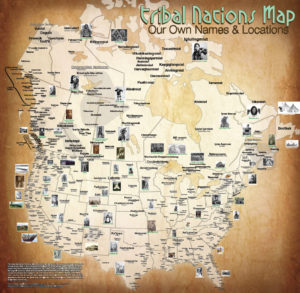Identity Development
In 2015, I invited school district colleague Uti Hawkins to speak to my students about Native identity development. In my invitation, I lamented that, while I could find identity frameworks for several racial groups, I could find no frameworks for Natives. So Uti wrote her own framework.
Notes on Native Identity, by Uti Hawkins
Self-Determination – Pre Colonial Encounter
Since Time Immemorial (Origin of Time) – Identity was rooted in origin stories, attitudes that related to the responsibility with the land, and tribal (nation) sovereignty.
(Pre-Clovis Paleoindian culture New Mexico ~11,000 years ago) – Compared to newest discovery along Florida’s Aucilla River dating 14,550 years ago.
Seeing historical knowledge and civilization integrity in an accurate timeline.
Identity was shaped by tribal traditions, community role, family status, and survival need/customs that had developed over thousands of years.
Way of life was balanced. Identity was not designated or segmented by religion and civilization.
Great emphasis on equity, pride/integrity, resilience – complexity of Iroquois federation, Southwest raiding, complex trade routes, existence of over 500 nations).
This is what is taught but with higher level understanding of timeline, one can transpose Native identity as evolutionary, transformative, and modern (out of the past tense).
Encounter – Colonial Invasion, 1492
Why “invasion”? It was WAR on land and identity.
A series of negotiations and small eye-opening events that had a culminating effect, as the war strategy was to de-Indianize.
Native nations and people interacting with sovereignty protocol. – Negotiating food and resource help, utilizing the (unowned land), integrating for survival, welcomed approached with nation-to-nation protocols and Treaties.
Euro-invaders acting to colonize, mission, and extract resources – “teaching” Natives to be “Euro-civilized,” institutionalized religion, forced labor, property ownership. No follow through of Treaties and refusal to implement responsibilities.
500 year war – Native accounting of history. American history told as conquering.
Historical Accuracy – Policies for Genocide and Killing of the Indian Identity
Systematic strategy of genocide:
1776 Early U.S. history (Invention of the Savage): taking away tribe and nation identity to build the Indian stereotype and killing the individual Indian.
1830 Removal Era (Segregation to Internment Camps): war, removing the presence of Indians from the mainstream and removing Natives from their land identity.
1850 Reservation and War (Assimilating and Conquering): destabilizing tribal structures and conformity to social and economic structures of rural America, removing the community identity from the Indian person, war on children, religion, POWs.
1930 Indian Reorganization Act (Needing Another Strategy): reversing the trend of breaking up tribes – identity is tied to the Tribal roles blood quantum, National Congress of American Indians, Johnson-O’Mally Act tries relations as sovereign-state reservations.
1945 Termination Period (Taking the Land and Changing the History): unrecognizing ~12,000 Native tribal Nations and their protected political status, manifest destiny land accumulation, American Indian Historical Society founded (“protecting and preserving” Native history).
1965 Self-Determination (Rejection of the Termination Policy and American Civil Right Movement)
2000 Urban Natives (The Census Needle Moves)
Oppositional Identity – negation of their culture
Encounter leaves individuals experiencing rage. alarm, confusion, depression, guilt from past naiveté. I.E. Redskins, teaching in the past tense, limiting the historical rhetoric.
No identity reconciliation; compromised identity means surrender and conquering.
Resulting in walking two paths: negotiating their acquisition of dominant culture and self-selecting invisibility.
Inter-tribal fighting for resources and quantifying being Indian enough.
Identity Immersion
Stopping the speaking of the language publicly and the expressing of traditions in community settings.
New perspective of “success” in education, job, and appearance.
Loss of Elders from war, disease, and foster care.
Intermarriage and cross cultural practices.
Denial of Native blood or assimilation by physical appearance.
Lateral violence and bullying within the community.
Identity Emersion
Introduction by tribe.
Appearance wearing or buying Native made clothing, jewelry and art.
Tribal card enrollment.
Actively acquiring oral historical knowledge about personal tribe or local tribe.
Healing from trauma, substance abuse, or family struggle.
Acknowledgement and learning of intergeneration-historical trauma.
Activism in helping better the community within and action to change the mainstream.
Internalization
No clear reconciliation.
Constant Representative – looked to as a universal representative.
Quantified by others vs. ownership of Native experience.
Substance abuse to medicate past trauma and current trauma.
Discontent walking in two world: rejection from tribal lands reservations to urban areas.
Isolation, depression, suicide, disengagement in school, substance abuse.
Responsibility to better generations ahead (7 generations), appropriation of history and Native studies.
Alternate Identity Framework
In Recording and Resources: Understanding Racial-Ethnic Identity Development, Dr. Chap discusses alternative framework:
“This is a model that was created by Alex Wilson, an Indigenous person and scholar. What she talked about was the complexity of identities for indigenous people. It’s not a staged model and it’s much more intersectional. One takes into consideration the indigenous group that they belong to, the sexual identity, the gender, the culture, community, spirituality, ancestors and the earth. Wilson says the identities of an indigenous person have to be seen within the context of all of these other aspects of culture, religion, spirituality, one’s relationship with the earth, one’s relationship with others.”
Resources
Website and Pages
Native-Land.ca, a resource to help North Americans learn more about their local history
The Map Of Native American Tribes You’ve Never Seen Before, from NPR
Teaching Native Issues, by the Zinn Education Project
28-3 “Indigenous Peoples’ History” Resource Guide, from Tribal College: Journal of American Indian Higher Education
Articles
Blackhorse: Native American? American Indian? Nope. Refer to Us By Our Tribe, Nation, from Indian Country Network
How I Feel As a Native Woman When Trump Idolizes Andrew Jackson, from Teen Vogue
Ryan McMahon’s 12-step guide to decolonization: why land matters, from CBC Radio
4 Ways To Honor Native Americans Without Appropriating Our Culture, from Everyday Feminism
8 Native women you should have learning about in history class, from Hello Giggles
8 Things The History Books Don’t Tell Us About Native People, from Everyday Feminism
13 Issues Facing Native People Beyond Mascots And Casinos, from Huffington Post
Videos
5 Girls on Why They’re Proud to Be Native American, from Teen Vogue
6 Misconceptions About Native American People, from Teen Vogue
9 Questions Native Americans Have For White People, from Buzzfeed
Two Spirits, One Dance For Native American Artist, from AJ+
Native American Girls Describe the REAL History Behind Thanksgiving, from Teen Vogue
Where the Spirit Lives, a CBC TV movie depicting the boarding school movement in Canada
J
Return to 11-Step Guide to Understanding Race, Racism, and White Privilege.






